
Review: Cheap board does its job
About half a year ago, Intel introduced its Atom CPU series, and performance in some tasks was quite a disappointment for us. Intel made a step in the right direction introducing its first dual-core Atom CPU, as this one might actually have what it takes to get the right performance in this ultra-cheap market segment.
A year ago Intel had a huge stock of 945G chipset and thought: "What can we do with this junk?" - Atom was born. It is still laughable that Atom consumes up to 4W, while the chipset needs much more than that. Even the dual-core Atom 330 with its 8W TDP is still better than any 945G.
Concurrently, Intel decided to limit the feature-set on these boards, so there won't be any board with PCIe slots, which would enable any user to put a decent graphics-cards in the machine. Intel naturally doesn't like to compete with itself and Atom 330 is a desktop-only CPU that should make it to the cheapest, low-end machines. Intel won't let anyone use Dual-core Atom 330 in netbooks, which is a shame as a notebook with dual-core Atom would definitely be a great idea, but it would probably hurt Intel's existing dual-core notebook sales.
Atom 330 comes with the new Intel board is called D945GCLF2, which is the most basic board you can imagine. Intel still is in the year 1996, as the board features legacy ports such as COM and LPT, and they still did not manage to put a DVI connector on the board.
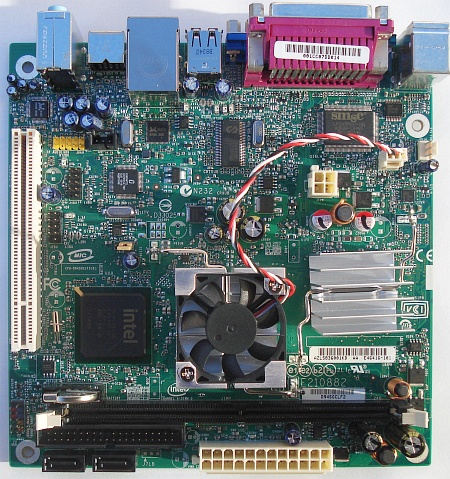
The most ridiculous decision Intel made is to put a 5500RPM fan on the Northbridge cooler. If you thought you can have a quiet machine because the CPU is passively cooled, you will be very disappointed. The system fan connector is badly placed, because there are many ITX cases which feature a fan on the right side, so there is a chance the fan-cable gets into the fan. Don't get confused because there is an ATX 2.2 power connector, it's not needed, any 20-pin ITX power-supply will just run fine, if it features a P4 CPU-power connector or if you have a HDD to CPU-power cable. A 60W ITX power-supply will suffice.

The backpanel is pretty standard, no suprises here.
Let's look at the new CPU:

As you can see, two dies of Atom N270s give you one Atom 330. So, Intel did not do something fancy like doing a real dual-core die. Just two dies stitched on the same socket. They did not improve the design at any level, still 32kB L1 instruction cache and 24kB L1 data cache with 512kB L2 cache but this CPU is suppose to be energy efficient, and it does a great job there.
The FPU is still slow and even a dual-core can't match a single-core Celeron 220. The Atom 330 is clocked at 1.60GHz and the total TDP of both cores are 8W, with a typical consumption of about 5W. The downside besides slow execution is the bundled 945GC chipset, which has a TDP of 22W and 3W for the ICH7 sSuthbridge.
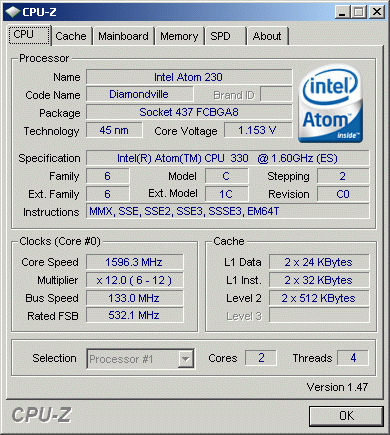
Testbed:
Intel D945GCLF2 Board (provided by DiTech)
Atom 330 dual-core 1.60GHz
iNTEL 945GC/iCH7
Memory:
A-Data 1GB PC2-6400 CL4
Graphics Card:
onboard
Power supply:
ITX 80W external/internal power supply
Hard disk:
Seagate Barraczda 7200.9 80GB (provided by Seagate)
DVD-Drive:
Optiarc AD-7543A
Benchmarks:
As you can imagine, two Atom N270 cores can't provide us with any performance miracles, but if you use software which can utilize two or four cores, the CPU will suffice for standard working environments.
Celeron 220:
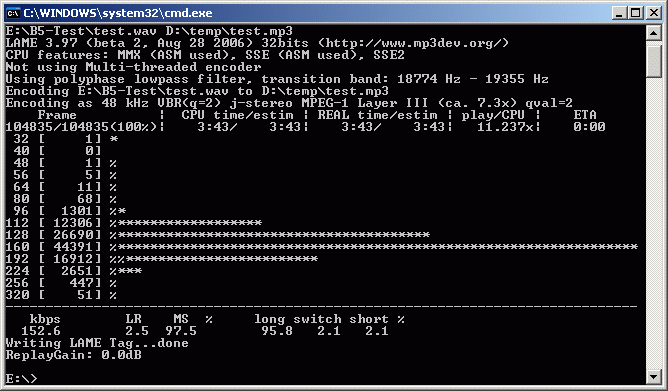
Atom 330:
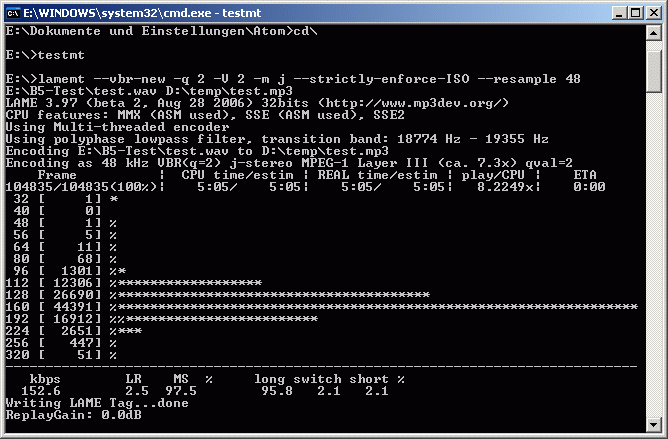
No surprises here, the Atom FPU/SSE Unit is still lame.
Celeron 220:
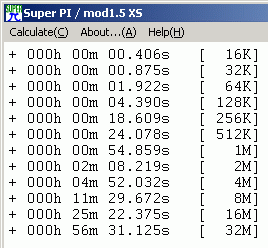
Atom 330:
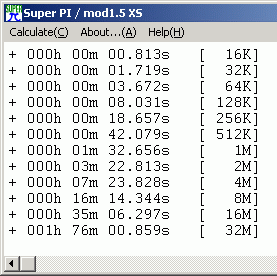
SuperPI runs only in one thread.
Sandra shows better results, because it utilizes all cores of any CPU::
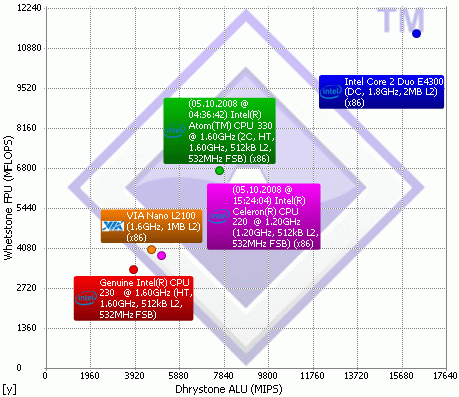
Here we see, the Atom 330 scales well, but it's no match for a cheap desktop CPU such as the old E4000 series. But at least the new Atom 330 can leave the Celeron 220 way behind, at least when using two cores/four threads.
Power Consumption:
We used lamemt and in case of the Atom 330 a 720p movie. A normal resolution movie will yield the same results as with the N270.
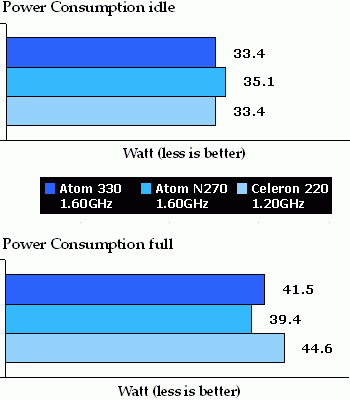
Atom 330 is doing well despite the fact the Northbridge/Southbridge is taking about 25W.
Conclusion:
Again, we tested if the new Atom 330 can play 720p stuff, at least when it plays from the hard drive. Atom 330 doesn't have any problems to play 720P and we suspect it can do 1080p. It's recommended to use ffdshow with classic media player to do so, because it utilizes dual cores and is much more efficient compared to any Microsoft or Apple codec. You can find the latest version here: http://sourceforge.net/project/showfiles.php?group_id=173941
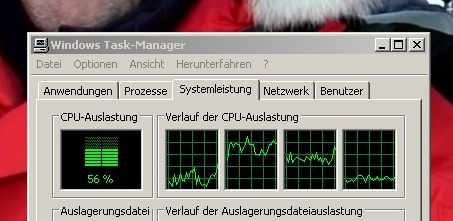
Click here for a bigger screenshot
To do a screenshot of a player you need to render with DX9 renderer, but DX output is much more CPU-intensive. If you have problems with playback we suggest you set your player to "overlay mixer".
Atom 330 is a good step forward. It will do all your office work, you can surf the Internet and even play HD content as long as you don't try that with a Blu-ray drive. The Northbridge/Southbridge combination is still disappointing. The Intel board, in particular, is quite boring and Intel has limited the feature-set to an absolute minimum. Besides that, the northbridge cooler makes working in a quiet environment impossible. There is some hope, because other vendors will do better boards and at least give us a proper DVI connector and a passively solution. You can clearly see that Intel's board around Atom 330 was the way to save as much money as possible.
The board with the CPU soldered is available for under €67,- which is quite cheap for a board with CPU.
